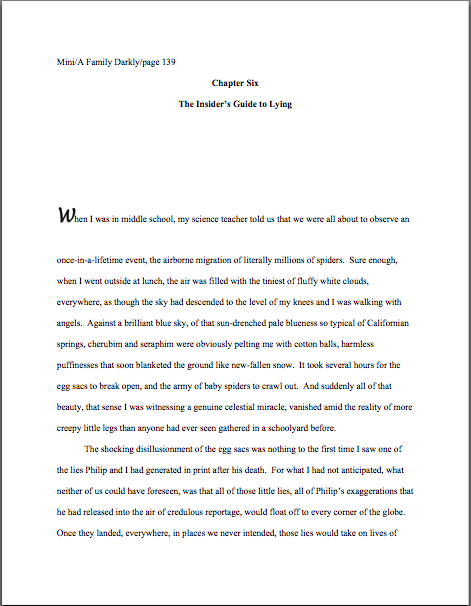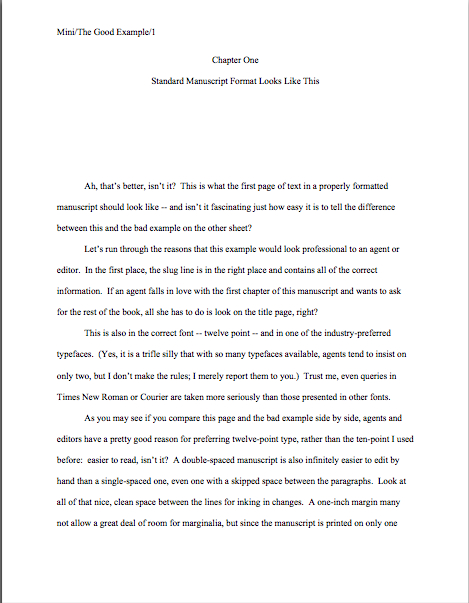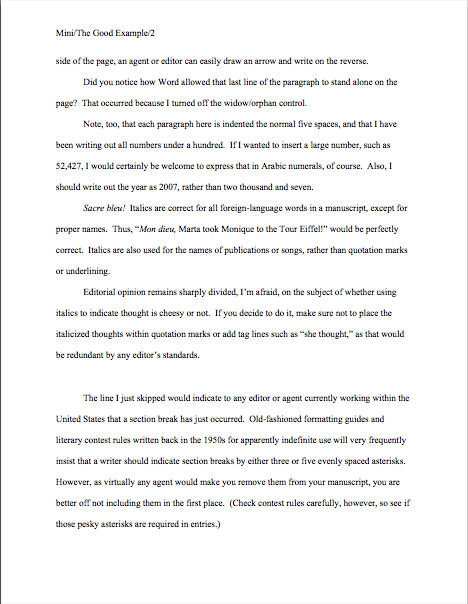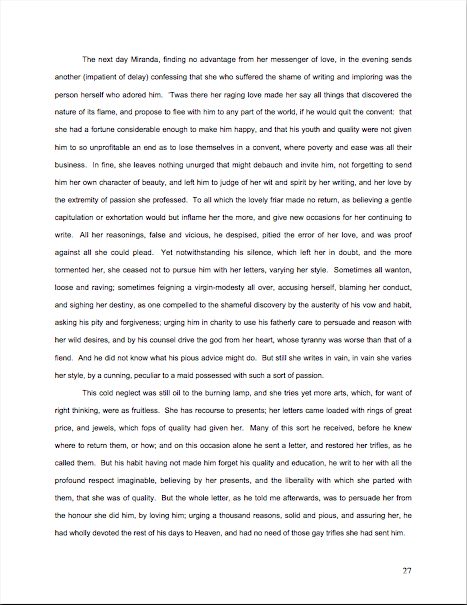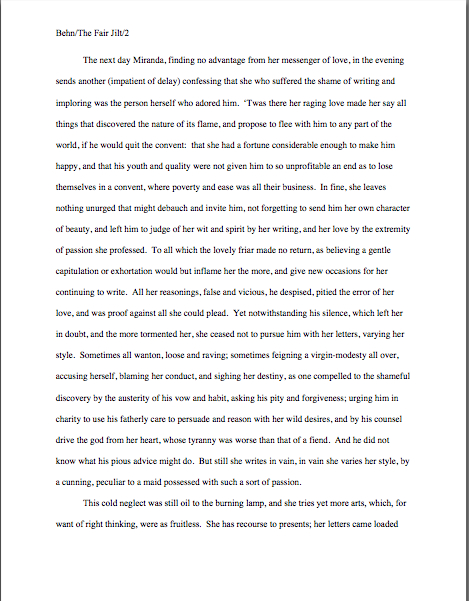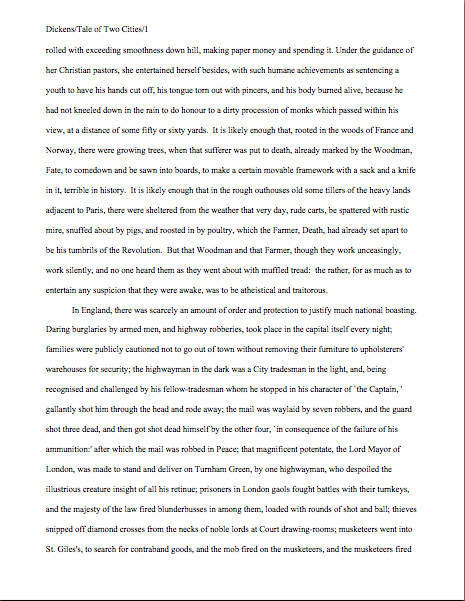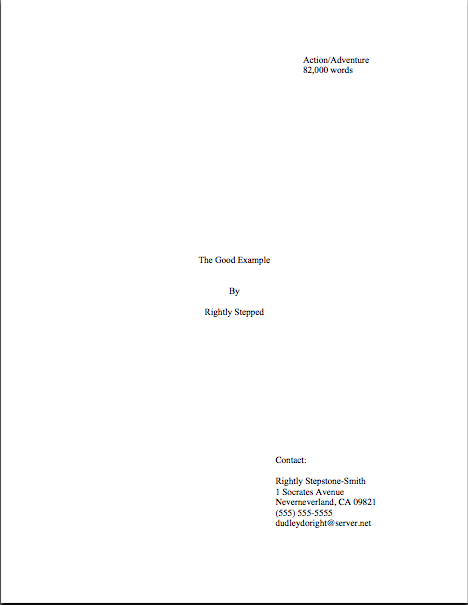Hello, campers –
I meant to post this yesterday, I swear; I had updated a former post while I was awaiting the departure of my much-delayed flight yesterday. But lo and behold, once I made it to my hotel, the one that had promised Internet access, were they set up for MacIntoshes? No, they were not. In fact, the in-house computer guy told me that if I intended to travel much, I should get a PC.
There being no polite reply to that sort of comment, you had to wait until today for the end of the Manuscript Formatting 101 series. Specifically, you had to wait until I was in an airport with wifi again.
Now that I read over the post, though, I notice something: it’s pretty darned redundant. I could edit it down, I suppose, to render it less so, but it’s such a beautiful example of what happens when the average writer works on a small screen (or revises her work on a small screen, as happened here) that I thought I would post the whole darned thing as a caution to everyone else who finds herself writing (or revising) on a precariously-balanced laptop under fluorescent lights while waiting for the second delayed flight in the course of two days.
Or if I am being too specific, for those who write and revise on small screens, period. It only goes to show you: some forms of redundancy are much, much more apparent in hard copy.
Just ask Millicent. Enjoy!
To polish off this extended series on manuscript formatting — book manuscripts, that is; please be aware that short stories, magazine articles, theses, dissertations, and other types of writing are subject to other restrictions — I’ve revised a post from last December, one I wrote in response to a reader’s expressed grumpiness (and who could blame her?) about the prospect of changing her manuscript from one space after each period and colon to two, as I had advised and indeed is proper in English prose.
I’m not going to lie to you, though: even amongst agents, preferences do differ on this particular subject. Although I’ve literally never heard of an agent’s asking a client to remove that second space, not every agent will tell his Millicent to take umbrage at its not being there.
So, like yesterday, we find ourselves in a situation where you have a choice to make. Return with me now to those thrilling days of last year, to talk about how to handle it.
Picture, if you will, a chilly holiday season, filled with twinkling lights, holiday joy, and a reader annoyed with some of my advice. I had been waxing long (invariably) and eloquent (I hope) on standard formatting, and intrepid reader Paula wrote in to take issue with my stand about the burning issue of whether the language has, without the intervention of the English professors of the world, spontaneously changed to require only one space between sentences and after colons, rather than two.
Business as usual here at Author! Author!, in other words.
As you may perhaps have been able to glean from the subtle clues I buried in the paragraph before last, it’s a topic upon which, as an editor, I have some fairly strong feelings.
How strong, you ask? Well, it wasn’t until I was well into my fourth page of response that it occurred to me that the comment sections weren’t subject-searchable, and thus I was unloading my hefty commentary in a place where posterity was unlikely to find it.
Fasten your seatbelts; I’m about to go to town.
As you MAY have noticed my whining about throughout this series, every time I do a post on standard format, readers write in to tell me that the rules have changed, on this point or on others. And frankly, they SHOULD be commenting, if they believe I have misspoken, or even if they feel a particular point requires further elucidation: false modesty aside, quite a few people do read this blog on a regular basis, and the last thing that I want to do is lead anyone astray inadvertently.
As I like to remind you all from time to time.
So please, folks, keep sending in those constructive comments and trenchant questions. Emphasis upon the constructive and pithy parts.
Apart from the community-support reason to ask follow-up questions, there is another, more self-interested reason that you should consider giving a shout if you think I’ve just told a real whopper: no writer, aspiring or otherwise, should apply a rule to her book without understanding WHY its application is a good idea.
Yes, even with something as basic as standard format.
If a particular suggestion doesn’t make sense to you, PLEASE don’t implement it just because I say so. Do it because you have thought about it and decided that trying it might help you market your writing.
I know, I know: life would be a whole lot easier if it came with a foolproof set of directions, and nowhere is that more true than in one’s first approaches to the publishing industry. It can definitely be confusing to a newcomer, fraught with unspoken expectations and counterintuitive requirements.
And, really, having spent a lifetime around them, if I were feeling lazy, I could conceivably just have given you a list of standard format requirements, dusted off my hands, and traipsed off to finish my holiday shopping.
Yes, I AM that organized, thank you very much.
Unexplained rule-flinging is not my style, however. I like to take the time to explain the rules, both to render submission less of a big, ugly mystery and to give my readers a chance to make up their minds for themselves. Call me wacky, but in the long run, I think my way helps people more than pronouncements from on high.
Speaking of pronouncements from on high, my correspondent began, charmingly, by quoting one of mine:
“In fact, in all of my years writing and editing, I have never — not once — seen a manuscript rejected or even criticized for including the two spaces that English prose requires after a period or colon. ”
Have you heard of a manuscript being rejected for using only ONE space between sentences? Within the past five years or so?
Isn’t that a trenchant question? Isn’t it about time I stopped yammering about the desirability of discussion and got around to answering it?
Here’s the short answer: rejected SOLELY upon that basis, no. It’s hard to tell for certain, though, because as I pointed out the other day, manuscript problems seldom travel alone. In order to prove this proposition absolutely, I would need to find that rara avis a submission that has positively no other problems and watch how it is received at agencies.
Starting to suspect me of being a bit flippant here? Well, you caught me: I am, but honestly, the notion that changing only ONE thing, even a major one, in the average manuscript would render it rejection-proof is not particularly easy to swallow.
Oh, I understand its appeal (and thus why clients, students, and blog readers ask about it so much): it would indeed be dandy if there were a magical formula that could be applied to any manuscript to render it pleasing to every Millicent out there.
Unfortunately, that formula doesn’t exist; individual tastes and market trends vary too much. Sorry to be the one to tell you that.
This is vital to understand about standard format: it’s not a magic wand that can be waved over a submission to make every agent, editor, and contest judge on the face of the earth squeal with delight at the very sight of it.
But it is a basic means of presenting your writing professionally, so your garden-variety Millicent will be able to weigh it on its non-technical merits. All I can claim for standard format — and this isn’t insignificant — is that adhering to it will make it less likely that your submission will be rejected on a knee-jerk basis.
However, I’m not going to lie to you: even a perfectly-formatted manuscript is going to garner its share of rejections, if it’s sent out enough. Why? Because every agent out there, just like every editor, harbors quirky, individuated ideas about how the perfect book should be written.
Everybody clear on that? Good. Let’s get back to Paula’s question, already in progress.
No, I haven’t seen submissions rejected ONLY on the basis of too-few spaces, but I have seen plenty formatted that way that also had other problems get rejected. But have I seen the practice criticized as unprofessional? Yes, often. Knocked out of finalist consideration as contest entries, absolutely.
And (just in case anyone’s still having trouble accepting the proposition that making this formatting tweak to a submission will automatically make the difference between rejection and acceptance) I’ve certainly heard it listed among several equally subtle points that led to rejection at agencies. Basically, like the other minor restrictions of standard format, it’s contributes to the sense that a writer just doesn’t know the ropes.
Have I flogged this dead horse into submission yet? No? Okay, I’ll keep going, then.
The irony, of course, is that so many of the folks who proselytize for the single-space style DO apparently regard this piece of formatting as precisely the kind of magic bullet that I just told you didn’t exist. No, seriously: the sources that claim the language HAS changed — and permanently, at that — tend to insist that skipping the second space after a period or colon, as our dear old white-headed English teachers taught us to do, automatically stamps a manuscript old-fashioned, obsolete, and generally silly.
In other words, that observing the standing rules of the English language is in and of itself a recipe for automatic rejection.
How do they justify this? The logic, as I understand it, runs thus: since printed books, magazines, newspapers, and to a great extent the Internet have been omitting these spaces in recent years, the language must therefore have changed. So much so that not only is leaving out the second space now permissible — which it definitely was not until very recently; Paula’s estimate of the last five years is pretty accurate — omitting it is now REQUIRED.
That sounds very serious, doesn’t it? Scary, even: nameless people might hurt you if you don’t take this advice.
Let me ask you something, though: if it is required, why isn’t the industry enforcing it in the ways that formatting restrictions are generally enforced, by agents and editors asking writers to change their submissions accordingly?
I’m not being flippant about this (for a change): while this rather radical formatting rule change has been popping up in a lot of fora that give advice to aspiring writers over the past five years, the actual practices of the industry have not seemed to be the engine behind the change.
Perhaps I lead a sheltered life, writing and editing up a storm in my little corner of the Pacific Northwest, but I have never seen (or heard) an argument in favor of omitting the second space made by anyone who works within the publishing industry — although I have chatted with a number of agents (including my own), who don’t mind the single space omission.
So it’s safe to say that the doubled space is still the norm — as long as we’re talking about MANUSCRIPTS.
Printed books, well, those are a different story — and here, I think, is where the confusion lies, because many publishers have made this change in their newer releases. Essentially, the proponents of eliminating the second space between sentences are arguing that what one sees in print is what one should reproduce on the manuscript page.
As I MAY have pointed out earlier in this series, publishers have made this shift in order to save paper. Which, as those of you who followed this last summer’s series of posts on the various aspects of marketing already know, is most emphatically NOT the goal of manuscript format, which aims toward ease of reading and hand-editing.
Omitting that second space does, as I mentioned, render it considerably harder to write corrections on hard copy. It may not seem like a lot of room, but believe me, when you’re trying to make four grammatical changes within a single sentence legibly, any extra bit of white space is a boon.
Hey, carrots are room-consuming. So are scrawls that read confusing, expand this, or Aristotle who?.
All of which editors have bestowed upon my manuscripts at one time or another, by the way.
I suspect that the underlying assumption of the second-space elimination movement is that editing on hard copy has gone the way of the dinosaur (it hasn’t), just because it is now feasible to send and edit manuscripts electronically. But just because it is technically POSSIBLE to eliminate paper from the process doesn’t mean that it occurs in practice all the time, or even very often.
This sort of jumping the gun in declaring long-standing practices dead, gone, and obsolete is hardly limited to manuscript submission, is it? Remember when Internet-based shopping first became popular, and technology enthusiasts assured us all confidently that the supermarket and shopping mall would be obsolete within a decade?
Turns out that a lot of people still wanted to squeeze melons and try on clothes before they bought them. Who knew?
Also, for the argument that the extra spaces are obsolete to makes sense on a practical level — or, at minimum, to generate the levels of resentment amongst agents and editors that its proponents predict — the industry would have to expect that every submission would be absolutely camera-ready by the time it hits a prospective agent’s desk.
In other words, in EXACTLY the format that it would appear in the finished book. Anybody see a problem with that?
As those of you who have been following the series wrapping up are already aware — at least you are if you’ve been paying attention and have a memory longer than a gnat’s — standard format for MANUSCRIPTS has little to do with how BOOKS are formatted. Heck, as I have been demonstrating for the past couple of weeks, manuscripts differ in many important respects from the format the Chicago Manual tells us to expect in a published book, or that AP style urges us to produce in a magazine or newspaper.
Which prompts me to ask: is it really SO astonishing that spacing would also differ? And why would a change in publishing practice necessarily alter what professional readers expect to see in a manuscript — especially when that alteration would unquestionably make their jobs harder?
And that, in case you were interested, Paula, is why I don’t embrace the practice of eliminating the second space between sentences in manuscripts. Until I see strong evidence that agents, editors, and contest judges have begun to FROWN upon the extra space, I’m going to continue to recommend it.
So there.
All that being said — and that was a rather lengthy all, wasn’t it? — I can certainly understand why aspiring writers who had gone the single-space route would be miffed at this juncture, though; changing that fundamental an aspect of a text could eat up a LOT of time. As, indeed, my insightful correspondent pointed out:
It took a lot of effort to train myself to STOP using the two spaces. It’s one of those grammatical rules that seems to have all but disappeared (much like the rather perplexing fad to omit the comma before the word “too”). If it’s necessary, I suppose there’s an easy “find and replace” way to correct my manuscript to add an additional space between sentences?
In the first place, I’m SO sorry you had to go through that, Paula. There’s nothing I can do about it, unfortunately — which saddens me, because I hear from so many Paulas who have had similar experiences — but I am genuinely sorry to hear about each of them.
In the second place, I’m very glad that the commenter brought up the comma elimination fad, because it provides a perfect parallel to what has happened with the spaces, or indeed, a certain Presidential candidate’s bizarre decision to eliminate the grammatically-necessary comma from the slogan Yes we can after he lifted it from the United Farm Workers (Si, si puede remember whence it came). Now, children all across this great land will think that comma is optional.
Annoying to those of us who wrangle words for a living? You betcha, to quote another recent candidate. But it does point up a moral we all would do well to bear in mind:
Just because a rule of grammar’s relaxation becomes common doesn’t mean that the rule itself has disappeared; it just means that breaking the rule has become marginally more acceptable.
For instance, these days, few people other than my mother would stop a conversation cold in order to correct a speaker who referred to “everyone and their beliefs,” but technically, it remains incorrect. To preserve subject-object agreement, it should be “everyone and his beliefs” or “everyone and her beliefs.” The reason for the loosening in common parlance is primarily sociological, I suspect: when American businesses (and television writers) began to take active steps to make language more friendly to women, the incorrect version sounded less sexist, and thus became widely accepted.
Does that mean that “everyone and their beliefs” magically became grammatically correct overnight? Not on your life. And the better-educated the intended reader- or listenership for the sentence, the more likely that the error will raise hackles.
On a COMPLETELY unrelated note, had I mentioned that Millicent, along with pretty much everyone who works in her agency, was probably an English major? Heck, she probably wrote her senior thesis on this kind of colloquial speech.
The fact is, the grammatical rule about the requisite number of spaces between sentences and after colons HASN’T changed — the PRACTICE has in many published works; in manuscripts, academic work (almost always the last to accept any sea change in the language), and private writing, the rule most emphatically has not.
As with splitting infinitives or ending sentences with prepositions — both of which were, as I like to point out to my mother, good enough for Shakespeare — while most people won’t care, the ones who DO care feel very strongly about it indeed. To them, it’s more serious than formatting: it’s a matter of literacy.
Don’t believe me? The next time you’re at a book signing by a Grand Old Literary Figure, walk up to him or her and speak a sentence ending with a preposition. (“Which college did you go to?” would suffice, for experimental purposes.) Then count the number of seconds of wincing before the GOLF can compose his or her features enough to respond to you with the courtesy due a long-time fan.
That may seem surprising, given that most of the aspiring writers who have embraced the practice of eliminating the second space report that they are doing it because some apparently authoritative source told them to make the switch — but tellingly, those sources’ certainty on the matter didn’t stop howls of protest from the professional reading community when Miss Snark (among others) suddenly started advising aspiring writers to leave it out.
Props to Miss S’ constituency, the result was pretty dramatic: mysteriously, half the submissions agents received were harder to read, and the change happened more or less overnight — and since most agents don’t read even the major writing blogs, it seemed to come out of nowhere.
How loud were those howls, you ask? Suffice it to say that the grumbles continue to this day. No one who edits text for a living would vote for this particular change. To most professional eyes, it still just — chant it with me now, readers of this series — looks wrong.
(Hey, I’ve just inadvertently brought up another grammatical rule that one often sees flung off as obsolete: the practice of making a proper name ending in s, either because it is plural or because the singular is spelled that way, possessive by adding an apostrophe after it: the Jones’ dog, rather than the Jones’s. No matter how many times you may have seen the latter in print in recent years, the former remains correct. Again, so there.)
To return to my correspondent’s last comment, yes, it’s a pain for the writer to make as all-pervasive a change to a manuscript as adding the necessary second space after periods and colons — but as you have probably already noticed, the industry is not exactly set up to minimize effort for writers.
Sorry. If I ran the universe…well, you know the rest.
That being said, I would caution any aspiring writer against assuming that any single problem, formatting or otherwise, was the ONLY reason a manuscript was getting rejected. Most of the time, it’s quite a few reasons working in tandem — which is why, unfortunately, it’s not all that uncommon for Millicent and her cohorts to come to believe that an obviously improperly-formatted manuscript is unlikely to be well-written.
So — everyone join in now; you know the words — changing the spaces between sentences alone probably isn’t going to be the magic bullet that results in instant acceptance.
A wiser person would probably sign off now, but I’m going to bite the bullet (not the magic one) and bring up the question that is probably on many, many minds at this juncture: barring a flash of insight from a reader or a well-timed act of celestial intervention, could you get away with retaining the single-space convention in a document already written?
As you may have gathered, I would not advise it, especially in a contest submission. However, it really is up to the individual writer. As much as writers would LIKE for there to be a single standard upon which every single person in the industry agreed, it just doesn’t happen.
As I keep saying (over and over again, I notice), there are exceptions in what individual agents and editors want; you might strike lucky.
If you DO decide to go the single-space route (picture me rending my garments here), make absolutely certain that your manuscript has NO other problems that might trigger Millicent’s ire. Also, be prepared for an agent to ask to make the change before the manuscript is submitted to editors — and, if asked, do it cheerfully and without explaining at length why you originally embraced the single-space practice.
Not that YOU would do such a thing, of course, but for those who don’t know better: agents and editors tend not to be amused when writers of first books lecture them on how the industry has changed, implying that those who haven’t really should get on the ball.
And this is definitely an instance where folks outside the industry have been making pronouncements about how the industry should operate for quite a while. Even if you are completely polite in how you express it, chances are that the last writer who made the case to Millicent’s boss was not.
The word Luddite may actually have been uttered.
Whatever course you decide to pursue, though, make it YOUR decision — and stick to it. Don’t leap to make every change you hear rumored to be an agent’s pet peeve unless you are relatively certain in your heart of hearts that implementing it will make your manuscript a better book.
Yes, even if the suggestion in question came from yours truly. It’s your manuscript, not mine.
Thanks for the great question, Paula, and everybody, keep up the good work!













